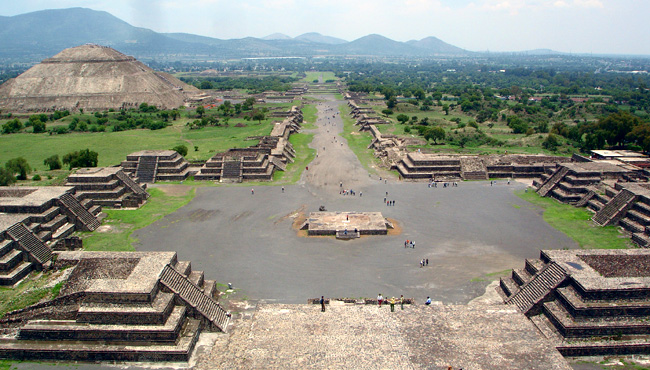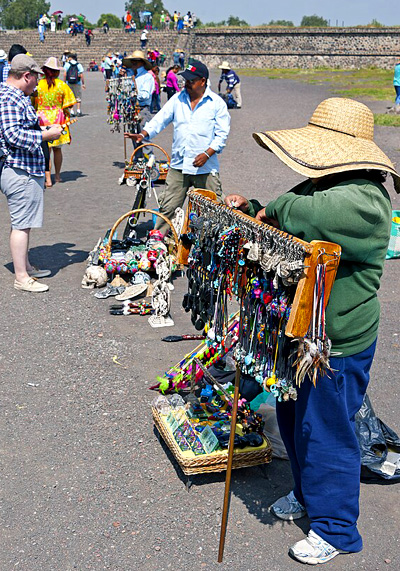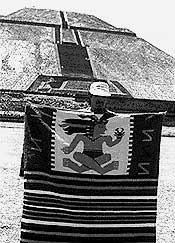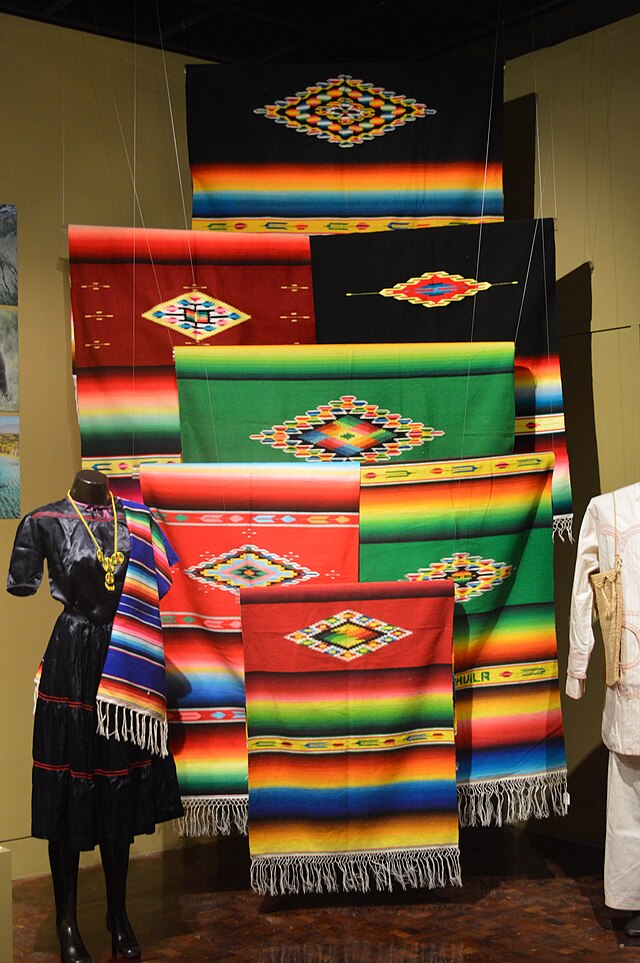
View of Teotihuacan, the Pyramid of the Sun on the left with the Avenue of the Dead past it, as seen from the Pyramid of the Moon; public domain image courtesy of "Jackhyne" made available through Wikimedia Commons.
About thirty miles northeast of Mexico City there stand some of the world's most spectacular ancient ruins, seen above, the 2,000-year-old remains of Teotihuacan. Two pyramids dominate the landscape, the largest measuring 500 by 400 feet at its base, and looming 140 feet above the surrounding flat, barren landscape. In the ruin complex visitors see interesting frescos in beautifully decorated temples, and visit a good museum. Hordes of international tourists visit Teotihuacan each day, and every visitor is approached by several Mexicans peddling everything from "authentic Aztec clay flutes" to fine, silver jewelry.

Vendors at Teotihuacan in 2015; copyright free image courtesy of Daniel Case made available through Wikimedia Commons.
An unfortunate dynamic often develops between tourists and souvenir vendors. Especially because visiting the ruin involves hiking long distances in bright sunlight, usually a time comes when the tourist is just too tired to be bothered with looking at souvenirs; yet the peddlers keep coming and coming. The peddlers, in turn, regarding themselves as hardworking folks simply trying to make honest livings selling superior goods at low prices, resent the visitors' aloofness and occasional grouchiness.

René Hernández Juárez selling sarapes in 1994
On the morning of my visit to Teotihuacan, perhaps the tenth souvenir peddler to approach me is a man between thirty and thirty-five years of age, with a foot-thick collection of woolen serapes slung over his shoulder. His name is René Hernández Juárez, and he's from the local village of San Juan Teotihuacan. When he sees that I'm a friendly fellow fluent in Spanish, he seems to decide to get some things off his chest:
"Our big problem is that nearly all the tourists who come here are brought by agencies," he begins. "Well, the agencies in North America are in contact with the Mexican agencies, and they work together, so when the agencies bring their people here they stop at certain stores and restaurants along the way. The guides tell the tourists that the stores' serapes, sculptures, etc. are the best quality, so the tourists buy their souvenirs there. Well, those guides not only get to eat for free in the restaurants, but they also get a 20% commission on all sales. Then the tourists arrive here not even knowing that we artisans are here selling our handicraft, and they don't have money left to spend on the things that can only be bought here."

Sarapes at the Museo de Arte Popular in Mexico City; copyright free image courtesy of "AlejandroLinaresGarcia" made available through Wikimedia Commons.
"And most of us are artisans. In my town, about half of the people are involved in producing handicraft sold here. For example, I'm a third-generation serape maker. My grandfather, Don Bifas Hernández Moreno, was a famous serape artisan from Santa Ana Chiautempan, Tlaxcala, and you know that Santa Ana is world famous for its serapes; the National Serape Fair is held there each year. My father saw the potential in selling serapes at Teotihuacan, so he moved here, and when he was established, my grandfather followed him. We are proud of our art, and we work hard to make the very best product."
"But, you know the very first thing the tourists do when I start walking toward them? They grab their wallets because they think I'm going to rob them. Well, think how that makes me feel. I'm just trying to earn my food, doing what my family has done for three generations... "